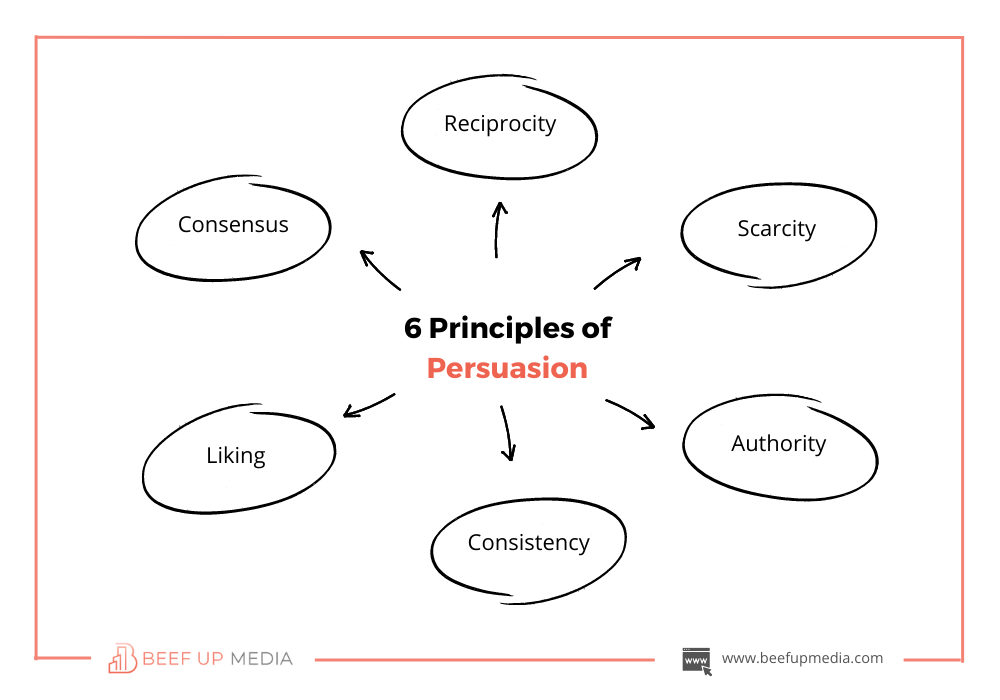Whether you accept it or not, we all persuade or get persuaded to do something on a daily basis.
But persuasion is more than that.
Persuasion is the art of convincing someone to not only take a particular action, but also adopt a certain belief, or change their mindset.
Although it is a vital skill in various aspects of life, including personal, professional, and social relationships… we’re gonna be talking primarily in the business & marketing sense here.
Now here’s the thing…
Persuasion can be used for good or bad, depending on the intentions and methods employed.
But we are gonna be talking about positive persuasion today.
I personally believe in influencing others in a constructive way, with the goal of enhancing their lives, building relationships, and/or achieving common goals.
Why use manipulation when you can do it constructively? Right?
Are we on the same page?
Then, let’s first start with…
Contents
Principles of persuasion
I don’t know if you’ve heard about Robert Cialdini.
He is a social psychologist and author of books like Influence and Pre-suasion.
If you’re in business and marketing, I’d highly recommend them.
According to Robert, there are six principles of persuasion:
- Reciprocity: People tend to feel obligated to return a favor when one is given. For example, if you do something nice for someone, they are more likely to do something nice for you in return.
- Scarcity: People tend to value things more when they are scarce or limited in availability. For example, if a product is marketed as a “limited edition,” people are more likely to want to purchase it.
- Authority: People tend to trust and follow the advice of those who are perceived as experts or authorities in their field. For example, if a doctor recommends a particular treatment, a patient is more likely to follow their advice.
- Consistency: People tend to prefer to be consistent with their beliefs and actions. For example, if someone commits to a particular decision, they are more likely to follow through with it.
- Liking: People tend to be more persuaded by those they like and feel a connection with. For example, if a salesperson is friendly and personable, a customer is more likely to buy from them.
- Consensus: People tend to look to others for guidance on what to do or believe. For example, if a product is popular and has many positive reviews, people are more likely to purchase it.
These are the basic principles.

There are certain types of appeals that can be combined with these principles and used to persuade people.
Types of persuasive appeals
There are primarily 3 types of persuasive appeals:
- Emotional appeal: This involves appealing to someone’s emotions, such as fear, anger, or happiness, to convince them to take a particular action or believe a certain idea.
- Logical appeal: This involves using facts, evidence, and reasoning to convince someone to take a particular action or believe a certain idea.
- Ethical appeal: This involves appealing to someone’s sense of morality or ethics to convince them to take a particular action or believe a certain idea.

Once you understand the above principles and appeals of persuasion, half of the job is already done.
But as I said, you can either use them in a good way or a bad way.
Persuading Positively
Positive persuasion emphasizes ethical and honest communication.
Not like negative persuasion, which could use misleading or manipulative approaches.
The benefits?
- Enhances relationships: Positive persuasion can help build stronger relationships between you and the audience.
- Increases trust: By being transparent and honest, people are more likely to trust you and the message being presented.
- Reduces conflict: By using positive persuasion, conflicts can be resolved in a non-confrontational and constructive way. This helps to reduce tension and promote cooperation.
Characteristics of Positive Persuasion
If you’re planning to persuade someone positively, there are certain characteristics you need to have.
These are a MUST.
Empathy
Empathy involves understanding and relating to other people’s feelings and experiences.
By showing empathy, you can build rapport and establish a connection with the other person.
Respect
Respect means showing consideration and regard for the sentiments and ideas of others.
By showing respect, you can create a safe and welcoming environment for discussion.
Honesty
Honesty involves being transparent and truthful.
(Pretty obvious, isn’t it?)
By being honest, you can build trust and credibility with the other person.
Authenticity
Authenticity involves being true to oneself and communicating in a genuine and sincere way.
By being authentic, you can establish a connection and build trust with the other person.
When you incorporate these characteristics in your messaging?
You can increase your effectiveness in influencing others in a constructive and positive way.

The theory and basics are all sorted.
Now, let’s look at the actual techniques to persuade people to take action.
Techniques for Positive Persuasion
These techniques are designed to help you influence others in a constructive and ethical way, by promoting mutual understanding and respect.
So use them wisely.
Active Listening
Active listening is not just hearing what the other person is saying.
It’s also attempting to comprehend their point of view and feelings.
This involves paying attention to the other person’s verbal and nonverbal cues and asking questions.
Active listening has several benefits, including:
- Building rapport and trust
- Creating a safe and comfortable environment for discussion
- Gaining a better understanding of the other person’s perspective and needs
- Reducing misunderstandings and conflicts
Some tips that can be used for active listening include:
- Maintaining eye contact
- Avoiding interrupting the other person
- Paraphrasing and summarizing what the other person is saying
- Asking clarifying questions
- Responding with empathy and understanding
Framing
Framing involves choosing and emphasizing certain aspects of an issue or message to make it more appealing to the other person.
This can be done by highlighting the benefits of a certain course of action, appealing to the other person’s emotions, or framing the message in a way that aligns with their values.
Framing has several benefits, including:
- Increasing the persuasiveness of the message
- Creating a connection with the other person’s values and beliefs
- Making the message more memorable and impactful
- Reducing resistance to the message
Some tips that can be used for framing include:
- Highlighting the benefits of a certain course of action
- Using emotional appeals
- Framing the message in a way that aligns with the other person’s values and beliefs
- Using metaphors or analogies to illustrate the message
Positive Language
Positive language involves using language that is optimistic, supportive, and encouraging.
This can be done by focusing on solutions instead of problems, using positive affirmations, and avoiding negative language.
Positive language has several benefits, including:
- Creating a positive and supportive environment for discussion
- Encouraging a solutions-focused mindset
- Reducing resistance to the message
- Increasing the persuasiveness of the message
Some tips that can be used for positive language include:
- Using positive affirmations
- Focusing on solutions instead of problems
- Avoiding negative language and criticism
- Using words and phrases that are uplifting and supportive
As much as these techniques are useful for positive persuasion, there are also some…
Barriers to Positive Persuasion
Positive persuasion can also be quite challenging.
To solve those challenges, identifying and understanding certain barriers is essential.
What barriers? ↓
Resistance
Resistance refers to the unwillingness of individuals to change their attitudes, beliefs, or behaviors.
People may resist persuasion for various reasons, including fear of change, lack of knowledge, or the perception that the persuader’s motives are self-serving.
How do you overcome resistance?
To overcome resistance, it is essential to understand the reasons for resistance and tailor your messages accordingly.
Using a non-threatening approach that acknowledges the other person’s autonomy and values is the key.
Providing sufficient information and addressing any misconceptions can also help alleviate the fear of change or lack of knowledge.
Prejudice
Prejudice refers to preconceived thoughts or attitudes against a specific group or individual based on perceived qualities such as race, ethnicity, gender, or religion.
Prejudice can lead to negative stereotypes and a lack of empathy towards the person or group being persuaded.
It can be caused by various factors, including cultural or societal norms, personal experiences, or upbringing.
How do you overcome prejudice?
It is crucial to address any negative stereotypes and foster empathy towards the person or group.
Using personal anecdotes, testimonials, or other forms of social proof can help challenge stereotypes and humanize the other person.
Moreover, building rapport and trust through active listening and respectful communication can help overcome barriers caused by prejudice.
Lack of Trust
Individuals who lack trust do not believe or have confidence in the persuader or the message being communicated.
A lack of trust can arise due to various factors, including previous negative experiences, lack of transparency and honesty, or a lack of credibility.
How do you overcome the lack of trust?
The most important key is to establish credibility and foster transparency and honesty.
Providing clear and concise information, addressing any concerns or objections, and demonstrating competence can help build trust.
Building rapport and emphasizing common goals or values can also help establish a foundation of trust and make it easier to persuade effectively.
Also Read: 3 Reasons why your customers aren’t buying & how to fix it
Final Thoughts
Positive persuasion is a great method for positively influencing others.
Moreover, it helps us ditch the manipulative approach to marketing.
And I think.. together we can make a conscious effort to practice positive persuasion.. can’t we?
Found this article helpful?
Sign up for The Marketing Fundamentals Newsletter (FREE) & you’ll find more golden nuggets inside on marketing & conversion to make your brand the talk of the town.




0 Comments